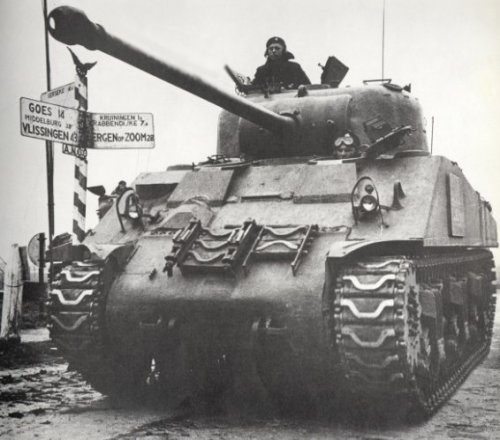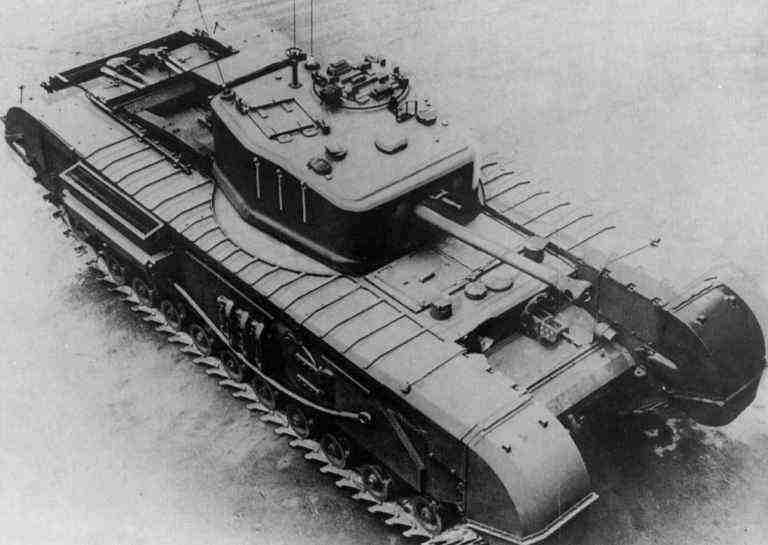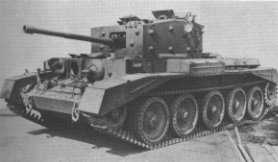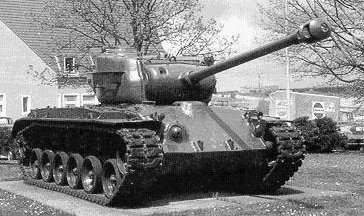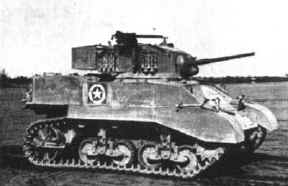
The M4 Sherman features as your main battle tank in all the US missions, and Training 1, Training 2, N158 Highway, and Barkmann Corner of the German missions as an enemy unit. The US Army vowed to win the war with this tank, and produced it in great numbers. A grand total of 49,234 were built, of which, 4,065 were sent to Russia and 17,181 to the British Army. It was classed as a medium tank, above the M5 Stuart and standardised in October 1941 as the M4. It soon became known as the �General Sherman�
The M4 was armed with the 75mm M3 gun, two .30 machine-guns, and one .50 machine gun. The machine guns were in the hull, the two .30s being fixed, and the .50 in a ball-mounted flexible position fired by the assistant driver. It was protected by 12-108mm (0.47-4.2in) of armour, 108mm being on the hull. It had a speed of 26mph, and a range of 100 miles on the road. The M4 had a Ford GAA V-8 engine, petrol driven with 18,029cc, and 450bhp at 2,600rpm. This engine was fairly reliable, and the suspension was Vertical Volute Spring Suspension (VVSS).
The First Shermans were mass-produced in 1942, under the British Army contract, before the US was drawn into the war in Europe. 8,389 M4 Shermans were built, of which 1,641 were fitted with 105mm howitzers instead of the 75mm gun.
The Sherman was the principal battle tank of the US and British Armies, but soon, the Sherman began to lag behind the technological advances of the German Tanks. Notably, it�s gun power. Because of this, 7 other variants of the original were created, of which, only two, the M4A1 (76), and M4A3e2 are featured in the game. The M4A1 (76) was named such because it was the first upgrade of the Sherman, and featured the 76mm M1 gun in the turret. The M4A1 appeared in 1942. 9,707 M4A1 Shermans were built, of which 3,426 were the M4A1 (76) as featured in the game, boasting a 76mm gun.
The M4 Shermans were one of the most numerous tanks of the war, along with the Russian T-34s. And like the T-34s, they won due to their numbers. The weaknesses of the Shermans became obvious in such battles as those in �Operation Market Garden� in Holland, and those in the �Battle of the Bulge� in Belgium and Luxembourg. Particularly at Poteau; another mission featured in the game. In these battles, the British and Americans suffered heavy losses at the hands of vastly superior German Tigers and 88mm field guns. However, the Shermans showed real strength in the Bocage countryside of Normandy, where their comparative agility and size to the German Panzers was an advantage. The Shermans had a chance of taking out a target before they were spotted in the bocage; because the Sherman Tank crews knew they would not stand up to many hits from the German armour! This is where half of the US missions are fought.
Length: 20ft 7in (6.27m) Width: 8ft 9in (2.66m) Height: 9ft 7in (2.93m)Weight: 31.07 tons (31,570kg)Crew: 5.
Sherman Firefly
The Sherman Firefly features in the German Hill 112, N158 Highway, and Villers-Bocage missions as an enemy unit. It is also a playable tank.
The Firefly was one of the very best tank-killers of the war. It was one of the few tanks to be able to penetrate a Tiger�s armour from upwards of 1000 yards. The idea was originally taken from the American tank destroyer, the M10, which sported the 3in gun. The British replaced the 3in with the far more superior 17-pounder gun, and the M10 became a formidable tank-destroyer. The same idea was applied to the Sherman, and the first Sherman Firefly tank was born on New Years� Day 1944.
The Sherman Firefly possessed exactly the same dimensions as the M4 Sherman, as it was essentially the same tank. However, the 17-pr gun set it apart from the rest. A special Shell type was developed for the 17-pr gun, the Armour Piercing Discarding Sabot (APDS). This new shell, coupled with the 17-pr was the best gun of the time, outperforming every gun there was, and equalling the German 128mm PaK44, penetrating 230mm of armour at 1000 yards. The APDS was introduced in August 1944, and was the best weapon the Allies had against the mighty German Tiger. The Firefly served all throughout the Normandy campaign, and served till the end of the war. It gained a reputation that filled the German tank crews with fear, as did the Tiger and Panther with Allied tank crews. The only way the German crews could tell the Firefly and M4 apart was from the very long 17-or gun the Firefly had. So the British tank crews went to great pains to disguise the turret to look like an M4 turret, so that they could take the German tanks by surprise.
Length: 20ft 7in (6.27m). Width: 8ft 9in (2.66m)
Height: 9ft 7in (2.93m) Weight: 31.07 tons (31,570kg)
Crew: 5.
Infantry Tank Mark IV � Churchill
The Churchill tank is included in the German Hill 112 and N158 Highway missions as enemy units.
The Churchill was originally designed to be an infantry tank to fight in trench warfare, which the military thought was what would happen again in WWII. In fact, Vauxhall completely re-worked it and by 1941, had come up with the Churchill tank. The Churchill was characterised by the tracks running up to the top of the hull, a deep-set front plate between the tracks, and it�s multi-wheel suspension. It was an extremely tough and reliable tank, and described as the best all-round tank of it�s time.
The armament originally consisted of a 2-pounder gun, but was upgraded to a 6-pr (The Marks III and IV), then a 75mm gun (The Marks VI, VII, and X), as found in the game. It also possessed two 7.92 Besa machine guns in the hull. Some close-support tanks had a 95mm howitzer instead of the 75mm (The Mark VIII). The armour ran from 16 to 152mm, and could be improved with the addition of extra plates. The Bedford 12cyl. petrol 21,240cc engine, with 350bhp at 2200rpm was fairly weak, which meant that the Churchill could only muster 16mph on the road. Though this wasn�t really an issue for such a strong tank, which also had a range of 88 miles.
The Churchill was first used in Dieppe by the Canadians, and it continued to serve throughout the war, and until 1965. It was kept up to date with constant improvements, and 11 different types were produced during the war years. The Mark VI being the version included in Panzer Front. Some Churchills were also sent to Russia, and the Churchill formed the basis for almost all of the 79th Armoured Divisions specialised armoured vehicles.
Length: 24ft 5in (7.44m) Width: 10ft 8in (3.25m)
Height: 8ft 2in (2.48m) Weight 38.95 tons (39,575kg)
Crew: 5
Cruiser Tank Mark IX - Cromwell Mark IV
The Cromwell features as an enemy tank in the German missions of Hill 112, and Villers-Bocage.
The Cromwell was part of the British line of Cruiser tanks, preceded by the Mark V Covenanter, Mark VI Crusader, and the almost identical Cavalier and Centaur. The Cromwell had a Rolls-Royce Meteor V12, petrol, 27,025cc engine, with 600bhp at 2,550rpm. This was actually a de-tuned version of the Merlin Spitfire engine. This engine enabled 31 mph and a range of 125 miles on the road, and was reliable and made the tank very agile. The Cromwell had 14-101mm of armour, and a variant of the Christie suspension.
The Cromwell, and the rest of the Cruiser class British tanks, were easily distinguished by the huge armour bolts on the turret, which are also visible in the game. The Cromwells, when they appeared in 1943, were fitted with a 6-pr gun. But the Mark IV, which appears in the game, boasted a British version of the American 75mm, with a 75mm gun barrel, and a 6-pr breech, so the new gun could fit into the older Cromwell models. The Marks IV and V went into production in November 1943.
The Cromwell fought well in the Western Front, and were eventually replaced by the Comet with its 77mm gun in March 1945. However, the Cromwell still went on to serve right through the war, and was well liked by its crews.
Length: 21ft 6in (6.55m). Width: 10ft 1in (3.07m)
Height: 8ft 8in (2.67m). Weight: 32.7 tons (33,224kg)
Crew: 5
The GMC M10
The M10 is not featured in the starting line-up in any of the missions in Panzer Front. But is included in the game as it is an important piece of allied armour.
The M10 isn�t strictly a tank, rather a Self-Propelled Gun. The chassis was based upon the M4A2 Sherman, but replaced the turret with a semi-open top, with a 3in M7 Anti-Tank Gun in it.
It carried 54 rounds for the 3in gun, and was driven by two GMC diesel engines, with 375bhp at 2,100rpm, giving it a road speed of 30mph and a range of 200 miles. The armour was a maximum 64mm, and it could fire either an HE (High Explosive) Shell, or tank-destroying APC (Armour Piercing) Shell, of 12lb 4oz, at a muzzle velocity of 2,800ft/sec (853m/sec).
The M10 was later replaced by the M10A1, which was exactly the same tank, but based on the M4A3 chassis rather than the M4A2, and using two Ford V-8 petrol engines, with 450bhp at 2,600rpm. Some M10s were sent to Britain, where they received an upgrade to the 17-pr gun, like the Firefly. Some others were sent to Russia. All the M10s the Americans sent away were diesel driven, as they preferred petrol driven M10A1s for logistical reasons.
Length: 19ft 7in (5.96m). Width: 10ft (3.04m)
Height: 8ft 2in (2.49m).Weight: 29.47 tons (29,937kg)
Crew: 5
Heavy Tank M26 (T26E3) Pershing
The M26 Pershing only features in Panzer Front bis, and is known as the T26E3.
Because of the great weaknesses of the M4 Sherman, the US Army needed a heavy tank, that would be comparable to the German Tiger. The first attempt was the Heavy Tank M6, but this was denied production even though it was standardised, and so a new project was started, resulting in the M26. The plan was for a tank to mount a 90mm gun, and have thicker tracks and better armour than the Sherman. And the M26 had all this.
The M26s 90mm M3 was the biggest gun on an American tank, which was what presented the difficulty in getting it approved by the American armoured board. This gun was a great improvement on the 75mm M3, and the 76mm M1 guns, and had much better penetration power. The M26 also boasted two .30 Browning machine guns, and one .50 Browning machine gun, as in the Sherman. The M26 was well armoured, with 51-102mm of armour, it could stand up to the German guns much better than the previous Shermans. The added weight of the extra armour, meant that the M26 used torsion-bar suspension like the German Tiger, rather than the Shermans VVSS. The engine was a Ford V-8 petrol 16,390cc engine, with 500bhp at 2,600rpm. This engine too was very reliable, and slightly more powerful than the Sherman engine. It gave a top speed of 30mph, almost as fast as the T-34, and a range of 110 miles on the road.
The Pershing served from January 1945, before the final design was even approved, because the Army staff overruled the Army ground forces proposal that it wasn�t properly tested. The M26 was finally standardised after it had served the whole of the war in 1945, and the war had ended! Hence it is sometimes known (as in the game) as the T26E3, which was its final project name, and the only thing the crews had to call it other than the Pershing. It had been demanded for a long time, and was received with relief by its crews, who respected it greatly. By the end of the war, 310 Pershings were in Europe. The M26 went on to serve on into the Korean War, where it also served very well.
Length: 22ft 4in (6.80m). Width: 11ft 6in (3.50m)
Height: 9ft 1in (2.76m). Weight: 41.07 tons (41,730kg)
Crew: 5
M5A1 Stuart
The M5A1 Stuart features as an enemy tank in the second German Training Mission, and is also a playable tank.
The M5A1 was armed with the 37mm M6 gun, and two .30 Browning machine-guns. It was protected by 12-51mm of armour, and had a speed of 36mph with a range of 100 miles on the road. The M5A1 had two Cadillac V-8 Series 42 engine, each with 5,670cc, and 220bhp at 4,000rpm, which were very reliable.
8,884 M5s were built between 1942 and 1945, many being M5A1s.
The M5A1 �General Stuart� was a version of the original M3 �General Lee/Grant�. A medium tank used in Africa by the British. The M3 Grant was done away with its 75mm gun, and turret-mounted .30 machine gun, and also shortened, becoming the M3 Light tank, and christened the Stuart. This M3 Light Tank had the same radial air-cooled engine as the M4 Sherman and M3 Grant, but this engine proved to be a problem in production. So a design was developed, where the engine was replaced with two Cadillac V-8s, and named the M5. This M5 underwent changes of improving the turret; enlarging it and putting space for the radio, and building a stowage box on the rear of the hull. This is the M5A1 in Panzer Front.
The M5s and M3s were a Godsend for the British in Egypt and North Africa, where the engine�s reliability in the dusty deserts was highly praised. The British crews also liked the compactness of the tank, as they were able to ship more over than the Medium M3s, and it�s ease of maintenance. The small gun was not a problem, as the tanks they came up against had less armour; particularly the Italian tanks, and they were supported by the stronger M3 Grants.
Length: 16ft 6in (5.02m) Width: 8ft 3in (2.51m)
Height: 7ft 6in (2.28m) Weight: 14.17tons (14,402kg)
Crew: 4

